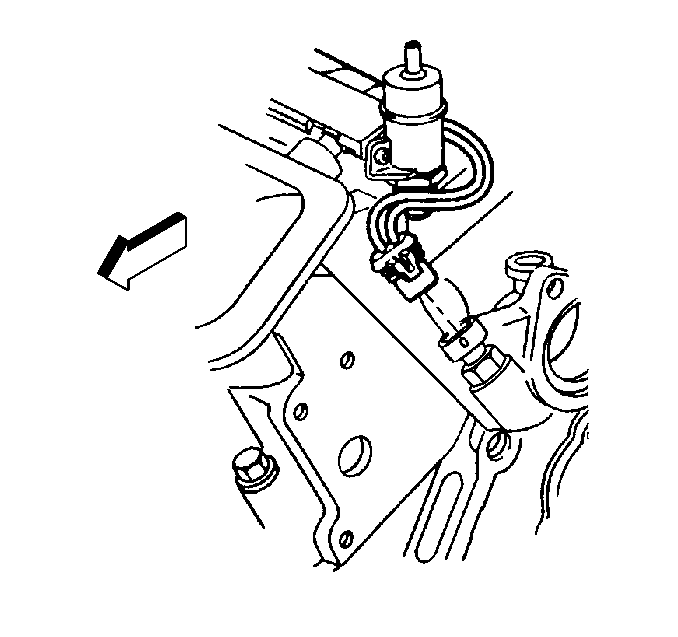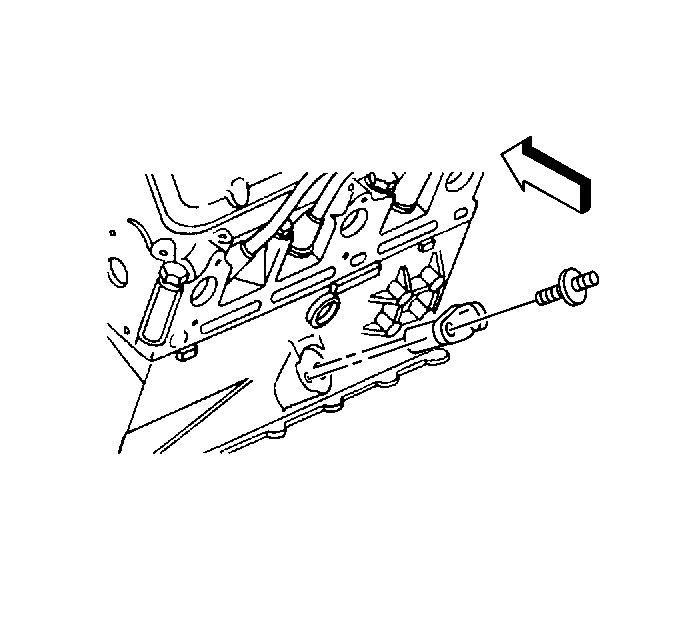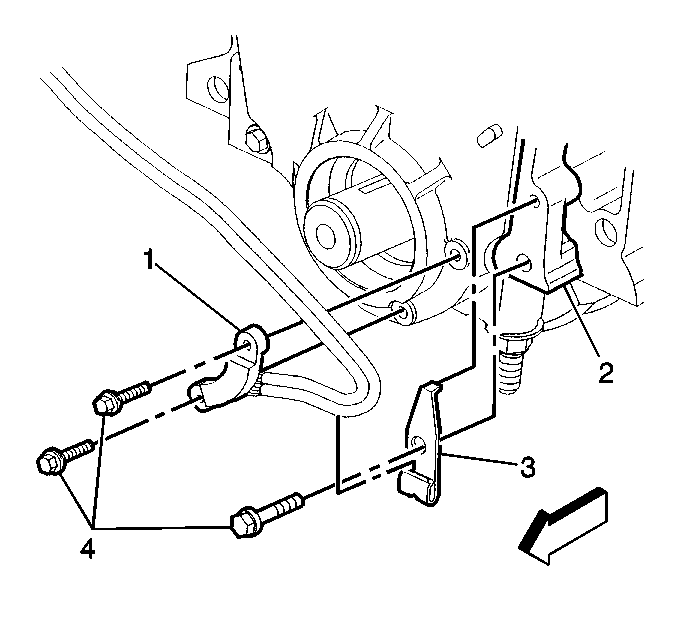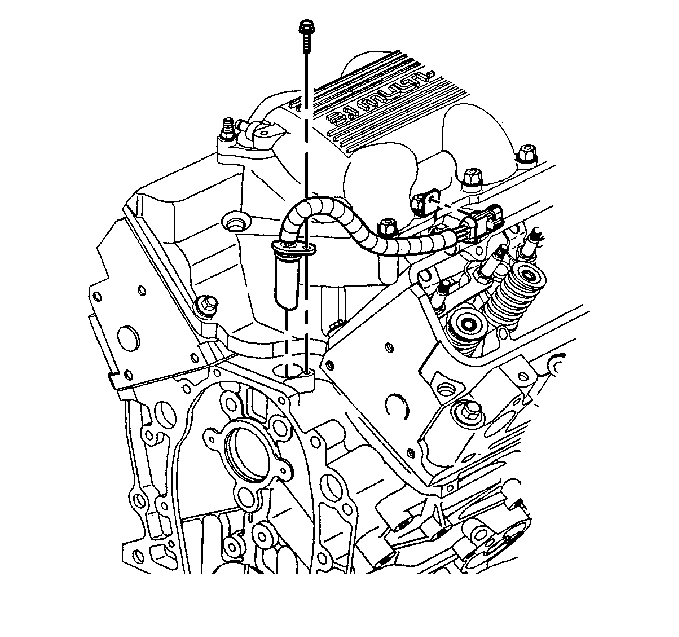All of the sensors and input switches can be diagnosed using a scan tool. Following is a short description of how the sensors and switches can be diagnosed by using a scan tool. The scan tool can also be used to compare the values for a normal running engine with the engine you are diagnosing.
Engine Coolant Temperature (ECT) Sensor

The engine coolant temperature sensor is a thermistor (a resistor which changes value based on temperature) mounted in the engine coolant stream. Low coolant temperature produces a high resistance (100,000 ohms at -40°C/-40°F) while high temperature causes low resistance (70 ohms at 130°C/266°F).
The PCM supplies a 5 volt signal to the engine coolant temperature sensor through a resistor in the PCM and measures the voltage. The voltage will be high when the engine is cold, and low when the engine is hot. By measuring the voltage, the PCM calculates the engine coolant temperature. Engine coolant temperature affects most systems the PCM controls.
The scan tool displays engine coolant temperature in degrees. After engine startup, the temperature should rise steadily to about 90°C (194°F) then stabilize when thermostat opens. If the engine has not been run for several hours (overnight), the engine coolant temperature and intake air temperature displays should be close to each other. A hard fault in the engine coolant sensor circuit should set DTC P0117 or DTC P0118; an intermittent fault should set a DTC P1114 or P1115. The DTC Diagnostic Aids also contains a chart to check for sensor resistance values relative to temperature.
The ECT sensor also contains another circuit which is used to operate the engine coolant temperature gauge located in the instrument panel.
Mass Air Flow (MAF) Sensor
The Mass Air Flow (MAF) sensor measures the amount of air which passes through it. The PCM uses this information to determine the operating condition of the engine, to control fuel delivery. A large quantity of air indicates acceleration, while a small quantity indicates deceleration or idle.
The scan tool reads the MAF value and displays it in grams per second (gm/s). At idle, it should read between 4gm/s-7gm/s on a fully warmed up engine. Values should change rather quickly on acceleration, but values should remain fairly stable at any given RPM. A failure in the MAF sensor or circuit should set DTC P0101, DTC P0102, or DTC P0103.
Intake Air Temperature (IAT) Sensor
The Intake Air Temperature (IAT) sensor is a thermistor which changes value based on the temperature of air entering the engine. Low temperature produces a high resistance (100,000 ohms at -40°C/-40°F), while high temperature causes low resistance (70 ohms at 130°C/266°F). The PCM supplies a 5 volt signal to the sensor through a resistor in the PCM and measures the voltage. The voltage will be high when the incoming air is cold, and low when the air is hot. By measuring the voltage, the PCM calculates the incoming air temperature. The IAT sensor signal is used to adjust spark timing according to incoming air density.
The scan tool displays temperature of the air entering the engine, which should read close to ambient air temperature when the engine is cold, and rise as the underhood temperature increases. If the engine has not been run for several hours (overnight) the IAT sensor temperature and engine coolant temperature should read close to each other. A failure in the IAT sensor circuit should set DTC P0112 or DTC P0113.
Manifold Absolute Pressure (MAP) Sensor
The Manifold Absolute Pressure (MAP) sensor responds to changes in intake manifold pressure (vacuum). The MAP sensor signal voltage to the PCM varies from below 2 volts at idle (high vacuum) to above 4 volts with the key ON, engine not running or at wide-open throttle (low vacuum).
The MAP sensor is used to determine manifold pressure changes while the linear EGR flow test diagnostic is being run (refer to DTC P0401), to determine engine vacuum level for other diagnostics and to determine barometric pressure (BARO).
If the PCM detects a voltage that is lower than the possible range of the MAP sensor, DTC P0107 will be set. A signal voltage higher than the possible range of the sensor will set DTC P0108. An intermittent low or high voltage will set DTC P1107 or P1106 respectively. The PCM can also detect a shifted MAP sensor. The PCM compares the MAP sensor signal to a calculated MAP based on throttle position and various engine load factors If the PCM detects a MAP signal that varies excessively above or below the calculated value, DTC P0106 will set.
The PCM updates the MAP sensor reading at each 3X reference pulse. If the 3X reference pulse is lost the PCM will only update the MAP sensor once per ignition cycle and will retain that value until the next ignition cycle. Depending on the retained MAP sensor value, the PCM will set the appropriate high voltage DTC or low voltage DTC.
Fuel Control Heated Oxygen Sensor (HO2S 1)

The fuel control Heated Oxygen Sensor (HO2S 1) is mounted in the exhaust manifold where it can monitor the oxygen content of the exhaust gas stream. The oxygen present in the exhaust gas reacts with the sensor to produce a voltage output. This voltage should constantly fluctuate from approximately 100mV (high oxygen content - lean mixture) to 900mV (low oxygen content - rich mixture). The heated oxygen sensor voltage can be monitored with a scan tool. By monitoring the voltage output of the oxygen sensor, the PCM calculates what fuel mixture command to give to the injectors (lean mixture-low HO2S voltage = rich command, rich mixture-high HO2S voltage = lean command).
The HO2S 1 circuit, if open, should set a DTC P0134 and the scan tool will display a constant voltage between 400 - 500mV. A constant voltage below 300mV in the sensor circuit (circuit grounded) should set DTC P0131, while a constant voltage above 800mV in the circuit should set DTC P0132. A fault in the HO2S 1 heater circuit should cause DTC P0135 to set. The PCM can also detect HO2S response problems. If the response time of an HO2S is determined to be too slow, the PCM will store a DTC that indicates degraded HO2S performance.
Catalyst Monitor Heated Oxygen Sensor (HO2S 2)

To control emissions of Hydrocarbons (HC), Carbon Monoxide (CO), and Oxides of Nitrogen (NOx), a three-way catalytic converter is used. The catalyst within the converter promotes a chemical reaction which oxidizes the HC and CO present in the exhaust gas, converting them into harmless water vapor and carbon dioxide. The catalyst also reduces NOx, converting it to nitrogen. The PCM has the ability to monitor this process using the HO2S 1 and the HO2S 2 heated oxygen sensors. The HO2S 1 sensor produces an output signal which indicates the amount of oxygen present in the exhaust gas entering the three-way catalytic converter. The HO2S 2 sensor produces an output signal which indicates the oxygen storage capacity of the catalyst; this in turn indicates the catalyst's ability to convert exhaust gases efficiently. If the catalyst is operating efficiently, the HO2S 1 signal will be far more active than that produced by the HO2S 2 sensor.
The catalyst monitor sensors operate the same as the fuel control sensors. Although the HO2S 2 sensors' main function is catalyst monitoring, it also plays a limited role in fuel control. If the sensor output indicates a voltage either above or below the 450 millivolt bias voltage for an extended period of time, the PCM will make a slight adjustment to fuel trim to ensure that fuel delivery is correct for catalyst monitoring.
A problem with the HO2S 2 signal circuit should set DTC P0137, P0138 or P0140, depending on the specific condition. A fault in the heated oxygen sensor heater element or its ignition feed or ground will result in slower oxygen sensor response. This may cause erroneous Catalyst monitor diagnostic results. A fault in the HO2S 2 heater circuit should cause DTC P0141 to set.
Throttle Position (TP) Sensor

The Throttle Position (TP) sensor is a potentiometer connected to the throttle shaft on the throttle body. By monitoring the voltage on the signal line, the PCM calculates throttle position. As the throttle valve angle is changed (accelerator pedal moved), the TP sensor signal also changes. At a closed throttle position, the output of the TP sensor is low. As the throttle valve opens, the output increases so that at Wide Open Throttle (WOT), the output voltage should be above 4 volts.
The PCM calculates fuel delivery based on throttle valve angle (driver demand). A broken or loose TP sensor may cause intermittent bursts of fuel from an injector and unstable idle because the PCM thinks the throttle is moving. A hard failure in the TP sensor 5 volts reference or signal circuits should set either a DTC P0122 P0123, P1350. A hard failure with the TP sensor ground circuit may set DTCs P0107, P0112, P0123 or P0117. Once a DTC is set, the PCM will use an artificial default value based on engine RPM and mass air flow for throttle position and some vehicle performance will return. A high idle may result when either DTC P0122 or DTC P0123 is set.
The PCM can detect intermittent TP sensor faults. DTC P1121 or DTC P1122 will set if an intermittent high or low circuit failure is being detected. The PCM can also detect a shifted TP sensor. The PCM monitors throttle position and compares the actual TP sensor reading to a predicted TP value calculated from engine speed. If the PCM detects an out of range condition, DTC P0121 will be set.
EVAP Vacuum Switch
The EVAP Vacuum Switch is used by the PCM to monitor EVAP canister purge solenoid operation and purge system integrity. The EVAP Purge Vacuum Switch should be closed to ground with no vacuum present (0% EVAP Purge PWM). With EVAP Purge PWM at 25% or greater, the EVAP Purge Vacuum Switch should open.
An incorrect EVAP Purge system flow should set a DTC P0441. A continuous purge condition with no purge commanded by the PCM should set a DTC P1441. A fault in the EVAP Purge Vacuum Switch circuit should set a DTC P1442. Refer to Evaporative Emission (EVAP) Control System for a complete description of the EVAP system.
EGR Pintle Position Sensor
The EGR pintle position sensor is an integral part of the EGR valve assembly. This sensor can not be serviced seperately from the EGR valve assembly.
The PCM monitors the EGR valve pintle position input to ensure that the valve responds properly to commands from the PCM and to detect a fault if the pintle position sensor and control circuits are open or shorted. If the PCM detects a pintle position signal voltage outside the normal range of the pintle position sensor, or a signal voltage that is not within a tolerance considered acceptable for proper EGR system operation, the PCM will set DTC P1406.
Knock Sensor (KS)
The knock sensor detects abnormal vibration (spark knocking) in the engine. The sensor is located on the engine block near the cylinders. The sensor produces an AC output voltage which increases with the severity of the knock. This signal voltage is input to the PCM. The PCM then adjusts the Ignition Control (IC) timing to reduce spark knock. DTCs P0325, P0326, and P0327 are designed to diagnose the KS module, the knock sensor, and related wiring, so problems encountered with the KS system should set a DTC.
Refer to Knock Sensor (KS) System for a complete description of the knock sensor system.
A/C Request Signal
This signal indicates to the PCM that an A/C mode is selected at the A/C control head. The PCM uses this information to adjust the idle speed before turning ON the A/C clutch. If this signal is not available to the PCM, the A/C compressor will be inoperative.
Refer to A/C Clutch Circuit Diagnosis for A/C clutch wiring diagrams and diagnosis of A/C clutch electrical system.
A/C Refrigerant Pressure Sensor
The A/C refrigerant pressure sensor signal indicates high side refrigerant pressure to the PCM. The PCM uses this information to adjust the idle air control valve to compensate for the higher engine loads present with high A/C refrigerant pressures and to control the cooling fans. A fault in the A/C refrigerant pressure sensor signal will cause DTC P0530 to set.
TCC Brake Switch
The TCC brake switch signal to the PCM indicates when the brake pedal is applied. The TCC brake switch information is used by the PCM mainly to control the Transaxle torque converter clutch.
Refer to SECTION 7 for a complete description and TCC brake switch diagnosis.
Transaxle Range Switch
The Transaxle Range Switch is part of the Transaxle Park/Neutral Position (PNP) switch mounted on the transaxle manual shaft. The 4 inputs from the transaxle range switch indicate to the PCM which position is selected by the Transaxle selector lever. This information is used for transmission shift control, ignition timing, EVAP canister purge, EGR and IAC valve operation.
The combination of the four transaxle range input states determine the PCM commanded shift pattern. The input voltage level at the PCM is high (B+) when the transaxle range switch is open and low when the switch is closed to ground. The state of each input is represented on the scan tool as X=high voltage level, 0=low voltage level. The four parameters represent trasaxle range switch Parity, A, B, and C inputs respectively
Gear Selector Position | Scan Tool Trans Range PABC Display X=High 0=Low | |||
|---|---|---|---|---|
P | A | B | C | |
Park (P) | 0 | 0 | X | X |
Reverse (R) | X | 0 | 0 | X |
Neutral (N) | 0 | X | 0 | X |
Drive4 (OD) | X | X | 0 | 0 |
Drive3 (3) | 0 | 0 | 0 | 0 |
Drive2 (2) | X | 0 | X | 0 |
Drive 1 (1) | 0 | X | X | 0 |
Transaxle Fluid Temperature (TFT) Sensor
The Transaxle fluid temperature sensor is a thermistor which changes value based on the temperature of the Transaxle fluid. A high Transaxle fluid temperature may cause the vehicle to operate in Hot Mode. While in Hot Mode, shift points may be altered, 4th gear disabled, and TCC forced ON in 2nd gear. A failure in the TFT sensor or associated wiring should cause DTC P0712 or P0713 to set. In this case, engine coolant temperature will be substituted for the TFT sensor value, and the Transaxle will operate normally. Refer to 4T60-E Automatic Transaxle Diagnosis for a complete description of the TFT sensor.
Vehicle Speed Sensor (VSS)
The Vehicle Speed Sensor (VSS) sends a pulsing voltage signal to the PCM which the PCM converts to miles per hour. This sensor mainly controls the operation of the TCC, shift solenoids, and cruise control systems. There are several different types of vehicle speed sensors. Refer to 4T60-E Automatic Transaxle for further information.
7X Crankshaft Position (CKP) Sensor

The crankshaft position sensor provides a signal used by the ignition control module. The ignition control module also uses the 7X crankshaft positon sensor to generate 3X reference pulses which the PCM uses to calculate RPM and crankshaft positon Refer to Electronic Ignition System for additional information.
24X Crankshaft Position (CKP) Sensor

The 24X Crankshaft Position (CKP) Sensor is used to improve idle spark control at engine speeds up to approximately 1250 RPM.
3X Reference Low
The PCM uses this signal, from the ignition control module to calculate engine speed and crankshaft position over 1280 RPM. The PCM also uses the pulses on this circuit to initiate injector pulses. If the PCM receives no pulses on this circuit, DTC P1374 will set and the PCM will use the 24X reference signal circuit for fuel and ignition control.
This is a ground circuit for the digital RPM counter inside the PCM, but the wire is connected to engine ground only through the ignition control module. Although this circuit is electrically connected to the PCM, it is not connected to ground at the PCM. The PCM compares voltage pulses on the reference input circuits to pulses on this circuit, ignoring pulses that appear on both. Refer to Electronic Ignition System for further information.
Camshaft Position (CMP) Sensor and CAM Signal

The camshaft position sensor sends a cam signal to the PCM which uses it as a 'sync pulse' to trigger the injectors in proper sequence. The PCM uses the CAM signal to indicate the position of the #1 piston during its intake stroke. This allows the PCM to calculate true Sequential Fuel Injection (SFI) mode of operation. If the PCM detects an incorrect CAM signal while the engine is running, DTC P0341 will set.
If the CAM signal is lost while the engine is running, the fuel injection system will shift to a calculated sequential fuel injection mode based on the last fuel injection pulse, and the engine will continue to run. The engine can be restarted and will run in the calculated sequential mode as long as the fault is present with a 1 in 6 chance of injector sequence being correct. Refer to DTC P0341 for further information.
SMCC Cruise Control Status Input
The stepper motor cruise control module sends the cruise status input to the PCM to indicate when cruise control is engaged. The PCM monitors the cruise status signal while commanding cruise to be disengaged via the cruise inhibit circuit. Any of the following conditions may cause the PCM to inhibit cruise control operation:
| • | Engine not running long enough for cruise control operation. |
| • | Transaxle range inputs indicate park, neutral, low, or reverse gear selected. |
| • | Engine speed is too high or too low. |
| • | Vehicle speed is too high or too low. |
| • | ABS system is active for longer than 2 seconds. |
Vehicle acceleration or deceleration rate is too high.
